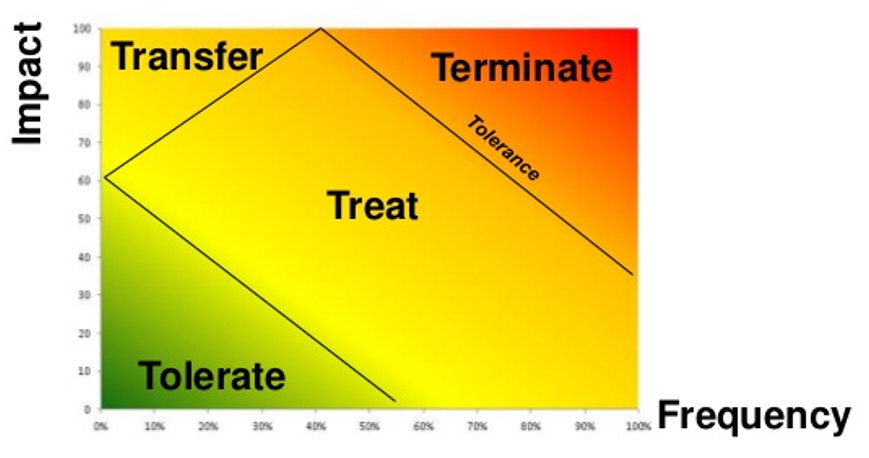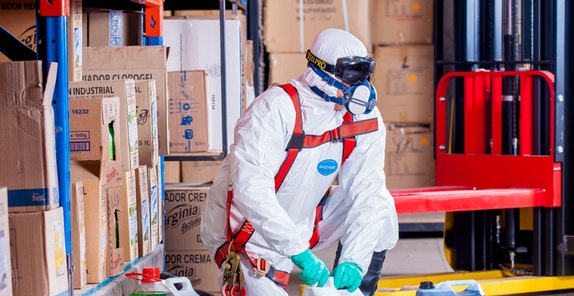Managing the Risk:
To manage the risk, it is necessary to know the potential hazards and the probability of occurrence of the hazardous event. Manage the risk as follows; these are also called 4 T’s of managing the risk. ( Treat, transfer, Tolerate and Terminate )
You live with the low-risk activities. (Tolerate)
Manage the medium-risk activities, by suitable control and mitigation measures. (Treat)
Avoid or eliminate high-risk activities or transfer them somewhere else (Terminate or Transfer)

Click on the link/s below to open the resources.
Example Of Risk Management w.r.t HCA
Precautionary Safety Procedures
The following precautions are taken and safety procedures are to be followed to prevent any incidents:
The toxic and hazardous chemicals are stored separately and in well-covered storage shed to protect them from direct sunlight.
The area is well-ventilated to keep the concentration level of toxic chemicals well below the PEL Values. (permissible exposure)
Compatibility is taken care of while deciding the storage location of individual chemicals. The flammable chemicals are stored away from oxidizing chemicals like hydrogen peroxide and nitrates.
The SDS of all the chemicals stored are available at the point of use, and the people are trained in SDS.
A sufficient number of fire extinguishers is available in the storage area. All the staff in the area is well trained in fire-fighting as well as first aid.
Safety shower and eyewash are readily available near the storage area and periodic inspection/ testing is done to keep them working at all times.
The first aid box is available in the stores.
The storage stock level of highly hazardous chemicals is maintained minimum to keep the hazard level low.
Sufficient stock of emergency PPEs like canister masks, escape masks, and breathing suits are maintained and all people working in the stores are well trained in the use of these safety PPEs.
All chemical storage containers are well marked and identified with a name label and other GHS hazardous symbols and Pictograms are followed.
People are required to take a bath if they are exposed to toxic chemical
A separate lunch room is provided to the workers to avoid any remote chance of food getting contaminated with toxic chemicals. People are advised to wash their hands thoroughly before taking lunch or tea.
All the transfer operations are mechanised as far as possible.
All the electrical fittings in the stores in the operation area are flameproof.
As the operations are done in a closed manner, it is transferred using a pump in order to avoid spillage.
The reactor controls are made automatic as far as possible and there are high temperature and high-level alarms are fitted to the reactor.
Smoking is strictly prohibited on the factory premises.
Nobody is allowed to carry any lighter or matchbox inside the factory premises in order to control the source of ignition and avoid the fire.
Respirator Zone
An employer must ensure:
That any workplace or part thereof under his or her control, where the concentration of an HCA in the air is or may be such that the exposure of an employee working in that workplace exceeds the restricted limit without the wearing of respiratory protective equipment, is zoned as a respirator zone;
That a respirator zone is clearly demarcated and identified by a notice indicating that the relevant area is a respirator zone and that personal protective equipment as contemplated in regulation 11 must be worn there; and
That no person enters or remains in a permanent respirator zone unless he or she is wearing the required personal protective equipment.
Personal Protective Equipment And Facilities

If it is not reasonably practicable to ensure that the exposure of an employee is adequately controlled as contemplated in regulation 10, the employer must:
- In the case of an airborne HCA, provide the employee with suitable respiratory protective equipment and protective clothing; and
- In the case of an HCA which can be absorbed through the skin, provide the employee with suitable non-HCA impermeable protective equipment.
Where respiratory protective equipment is provided, the employer must ensure:
- That the relevant equipment is capable of controlling the exposure to below the OEL for the relevant HCA;
- That the relevant equipment is correctly selected and properly used.
- That information, instructions, training and supervision, which is necessary with regard to the use of the equipment, is known to the employee; and
- That the equipment is kept in good condition and efficient working order.
An employer must, as far as is reasonably practicable:
- Not issue any used personal protective equipment to an employee, unless the relevant protection equipment is decontaminated and sterilised.
- Provide separate containers or storage facilities for personal protective equipment when not in use; and
- Ensure that all personal protective equipment not in use is stored in only the place provided therefor.
An employer must, as far as is reasonably practicable, ensure that all contaminated personal protective equipment is cleaned and handled in accordance with the following procedures:
- Where personal protective equipment is cleaned on the premises of an employer, care must be taken to prevent contamination during handling, transport and cleaning.
- Where personal protective equipment is sent off the premises to a contractor for cleaning purposes, the equipment must be packed in impermeable containers.
- The impermeable containers must be tightly sealed and must have a clear indication thereon that the contents thereof are contaminated; and
- The relevant contractor must be fully informed of the requirements of these regulations and of the precautions that must be taken for handling contaminated personal protective equipment.
Subject to the provisions of sub-regulation (4)(b), an employer must ensure that no person removes dirty or contaminated personal protective equipment from the premises: Provided that where contaminated personal protective equipment has to be disposed of, it is treated as HCA waste as contemplated in regulation 15.
Subject to the provisions of the Facilities Regulations, an employer must, where reasonably practicable, provide an employee who is using personal protective equipment, as contemplated in sub-regulation (1), with:
- Adequate washing facilities, which are readily accessible and located in an area where the facilities will not become contaminated, in order to enable an employee to meet a standard of personal hygiene consistent with the adequate control of exposure and to avoid the spread of an HCA;
- Two separate lockers separately labelled "protective clothing" and "personal clothing", and ensure that the clothing is kept separately in the locker concerned: and
- Separate "clean" and "dirty" change rooms if the employer uses or processes an HCA to the extent that the HCA could endanger the health of persons outside of the workplace.
Prohibitions
No person may, as far as is reasonably practicable:
Use compressed air or permit the use of compressed air to remove particles of an HCA from any surface or person.
Smoke, eat, drink or keep food or beverages in a respirator zone or permit any other person to smoke, eat, drink or keep food or beverages in that zone.
Use statements such as "non-toxic", "non-harmful", "non-polluting" or "non-hazardous" or similar statements indicating the HCA as not hazardous, or any other statements that are inconsistent with the HCA's GHS classification on the label or packaging of any HCA; and
Manufacture, procure, use, handle or store within the workplace:
- A prohibited HCA is listed in Table 1 of Annexure 2.
- Ozone-depleting substances provided for in the Regulations regarding the Phasing-Out and Management of Ozone Depleting Substances, published as Government Notice No. R. 351 of 8 May 2014: and
- Persistent organic pollutants are prohibited by the Prohibition on the Import, Export, Possession, Acquisition, Sale, Use and Disposal of Agricultural Remedies, under section 7 of the Fertilizers, Farm Feeds, Agricultural Remedies and Stock Remedies Act, 1947 (Act No. 36 of 1947), published as Government Notice No. R. 862 of 29 July 2016.
Offences and Penalties
STAATSKOERANT, 29 Maart 2021 No. 44348 33
Any person who contravenes or fails to comply with any provision of regulations 3, 4, 5, 6, 7, 8, 9, 10, 11, 12, 13,14, 14A, 14B, 14C or 14D shall be guilty of an offence and liable on conviction to a fine or to imprisonment for a period not exceeding six months and, in the case of a continuous offence, to an additional fine of R500 for each day on which the offence continues or additional imprisonment of one day for each day on which the offence continues: Provided that the period of such additional imprisonment shall in no case exceed 90 days.